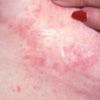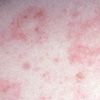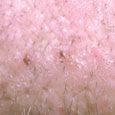Tinea and Lichen Simplex Chronicus Associated With Hepatitis C
For the past month, a 67-year-old woman has had a pruritic rash under her left breast. She takes an antihypertensive and is otherwise healthy.

Case 1:
For the past month, a 67-year-old woman has had a pruritic rash under her left breast. She takes an antihypertensive and is otherwise healthy.
What does this look like to you?
A.
Candidiasis.
B.
Intertrigo.
C.
Erythrasma.
D.
Tinea.
E.
Contact dermatitis.
(Answer on next page.)

Case 1: Tinea
A potassium hydroxide evaluation for dermatophytes confirmed the diagnosis of tinea, D, although no obvious source could be identified. The rash responded quickly to an antifungal cream.
Candidiasis usually features satellite lesions that extend from the periphery. Intertrigo is a diagnosis of exclusion; it is caused by heat and chafing. Erythrasma resembles this patient's rash, but it responds to topical antibacterial therapy. Contact dermatitis is typically bilateral.

Case 2:
A 43-year-old woman has had generalized pruritus for several months. She says that the skin appears normal but "itches like crazy"; however, she is able to stop herself from scratching. Treatment with diphenhydramine has not been effective. She takes no other medications and claims to be in good health.
Which of the following would you order next?
A.
A complete blood cell (CBC) count.
B.
A comprehensive metabolic panel.
C.
An antinuclear antibody test.
D.
Measurement of thyroid-stimulating hormone level.
E.
Measurement of free T
4
level.
F.
A chest film.
G.
Consultation with a psychiatrist or a psychologist.
(Answer on next page.)

Case 2: Lichen simplex chronicus associated with hepatitis C
A comprehensive metabolic panel, B, revealed elevated liver enzyme levels; further testing showed that this patient had hepatitis C. She underwent therapy for viral hepatitis and also received UV light treatment, which slowly relieved the pruritus.
Polycythemia vera is a consideration, especially if the pruritus worsens after showering. Hypothyroidism and hyperthyroidism are associated with pruritus, even in the absence of other symptoms. Thus, a CBC count, A, and thyroid function tests, D and E, would also be appropriate to order.
Cutaneous lupus usually features characteristic skin lesions. In a patient with unexplained pruritus, a chest film will on rare occasion reveal hilar adenopathy, which points to a diagnosis of lymphoma. If the pruritus is thought to be factitial, a psychological consultation is not unreasonable after organic causes have been eliminated.

Case 3:
For 4 days, a 51-year-old man has had a pruritic rash on his trunk and proximal extremities; it erupted after he took an unknown herbal remedy for an upper respiratory tract infection. He also takes vitamin supplements but no prescription medications.
What do you suspect?
A.
Maculopapular drug reaction.
B.
Urticaria.
C.
Erythema multiforme drug reaction.
D.
Erythema multiforme from upper respiratory tract infection.
E.
Sunburn reaction.
(Answer on next page.)

Case 3: Maculopapular drug reaction
A pruritic eruption that consists of erythematous papules that coalesce over time is characteristic of a maculopapular drug reaction, A.
The lesions of erythema multiforme are usually target-like and painful. Urticaria consists of pruritic erythematous wheals that appear and resolve in 24 to 48 hours. Sunburn produces confluent lesions that are confined to sun-exposed areas.
The patient was advised to discontinue the herbal remedy. An oral antibiotic for the upper respiratory tract infection and a short, tapering course of prednisone produced a full recovery.

Case 4:
A 26-year-old woman presents with a pruritic rash on her trunk that erupted when she started swimming over the summer. She has seasonal allergies that are well controlled with an oral non-sedating antihistamine. She owns a cat and works indoors. Her only other medication is an oral contraceptive.
What is your clinical impression?
A.
Nummular eczema.
B.
Tinea corporis.
C.
Pityriasis rosea.
D.
Urticaria.
E.
Contact dermatitis.
(Answer on next page.)

Case 4: Nummular eczema
This patient had a flare of atopic dermatitis caused by excessive time in the water, which removed the protective oils from her skin. As a result, nummular eczema, A, developed. Application of moisturizer before and after swimming and use of a mid-potent corticosteroid cream helped resolve the rash.
It would be unusual for tinea corporis to be as extensive as the eruption seen here. Pityriasis is a reasonable consideration, although the presence of a herald patch, a "fir tree" distribution, a preceding viral illness, and confinement to the trunk and proximal extremities would better support this diagnosis. Urticaria typically comes and goes and is not scaly or crusty. The distribution of this patient's rash is slightly patchy for a contact dermatitis, and she does not have a strong history of contactant exposure.




